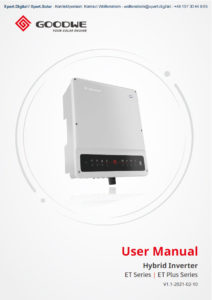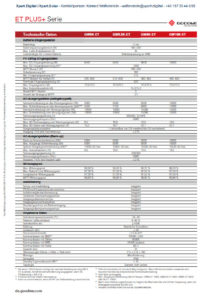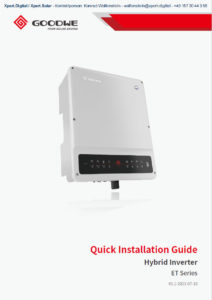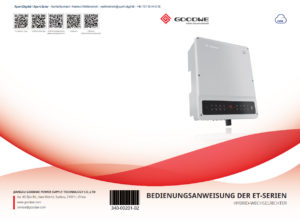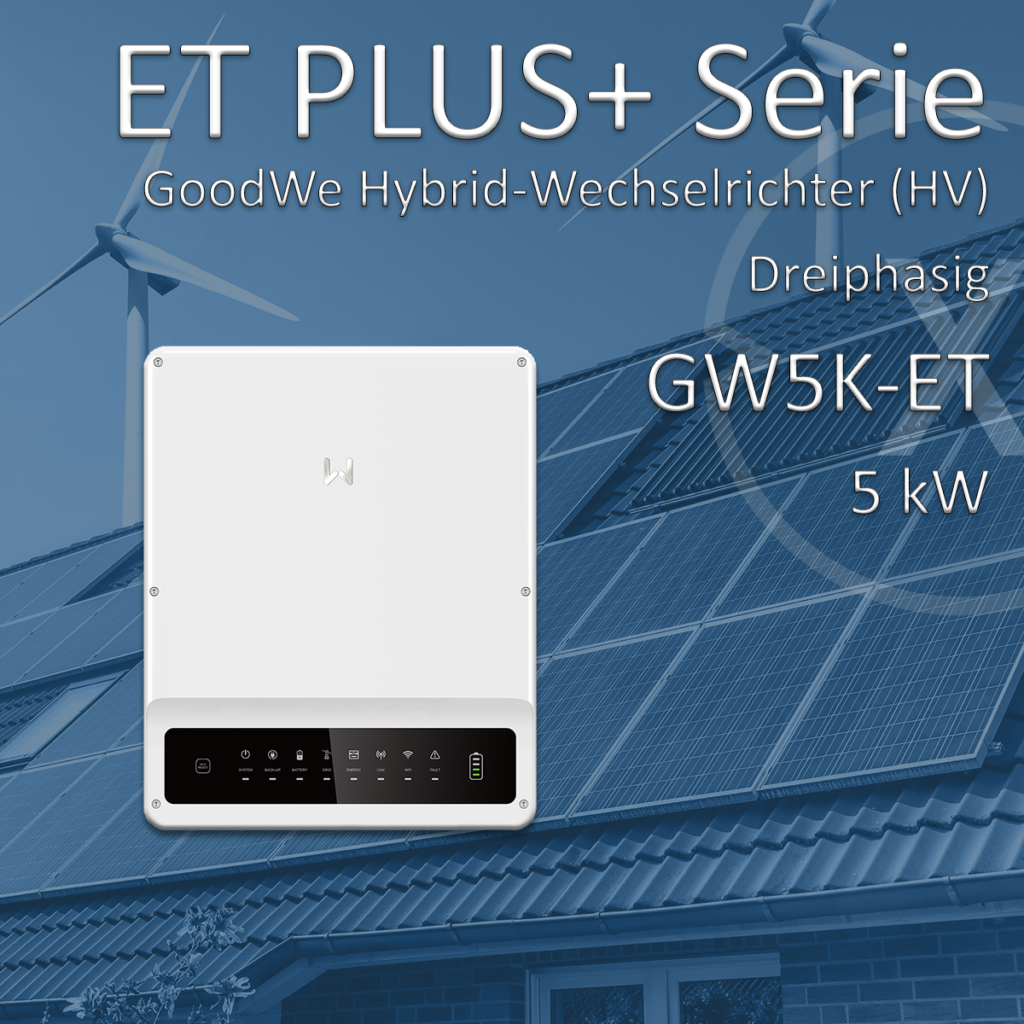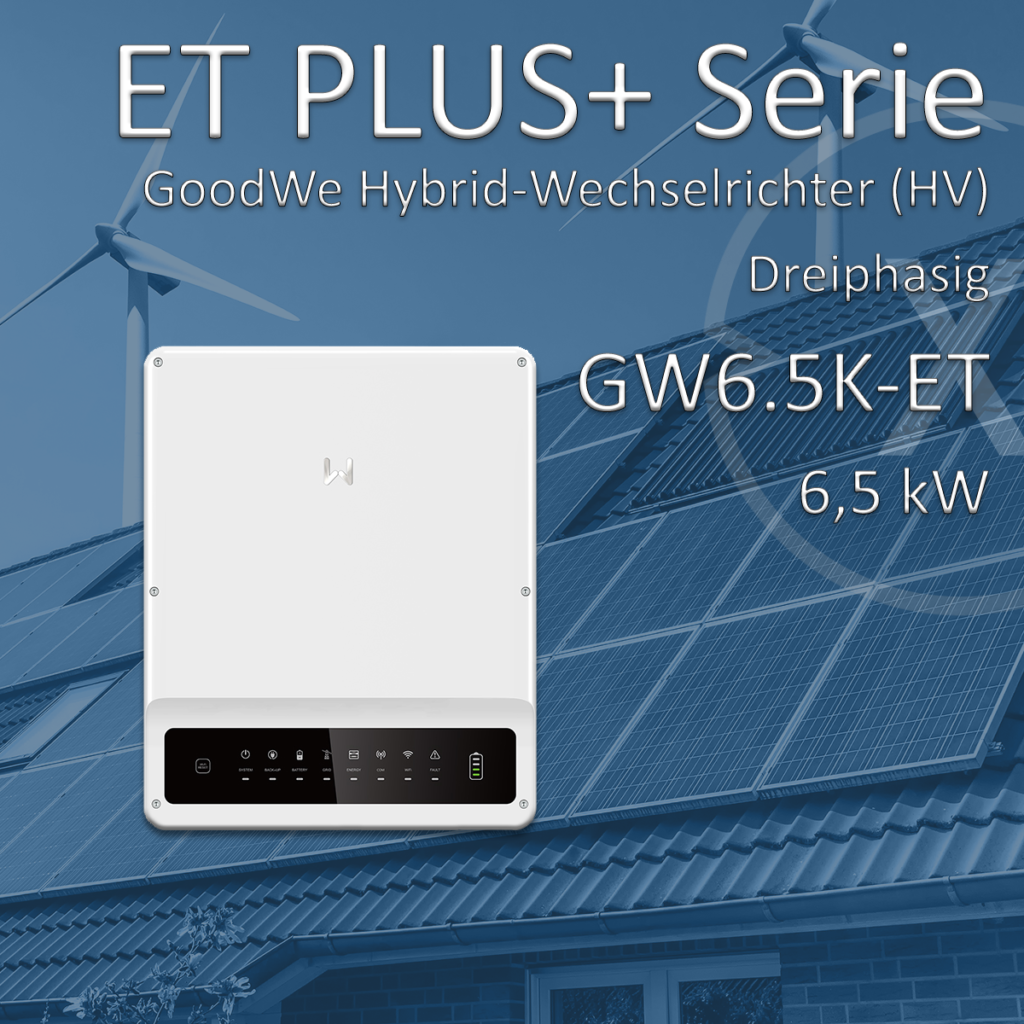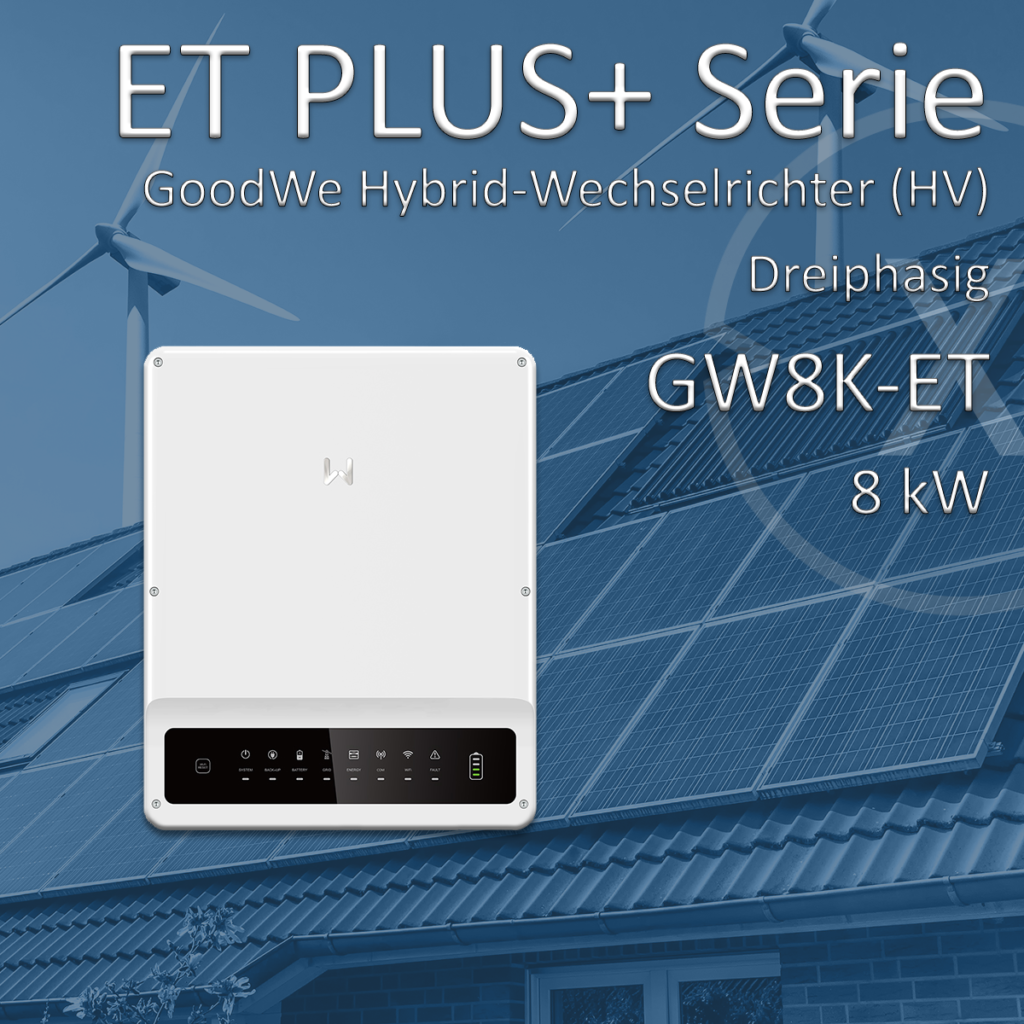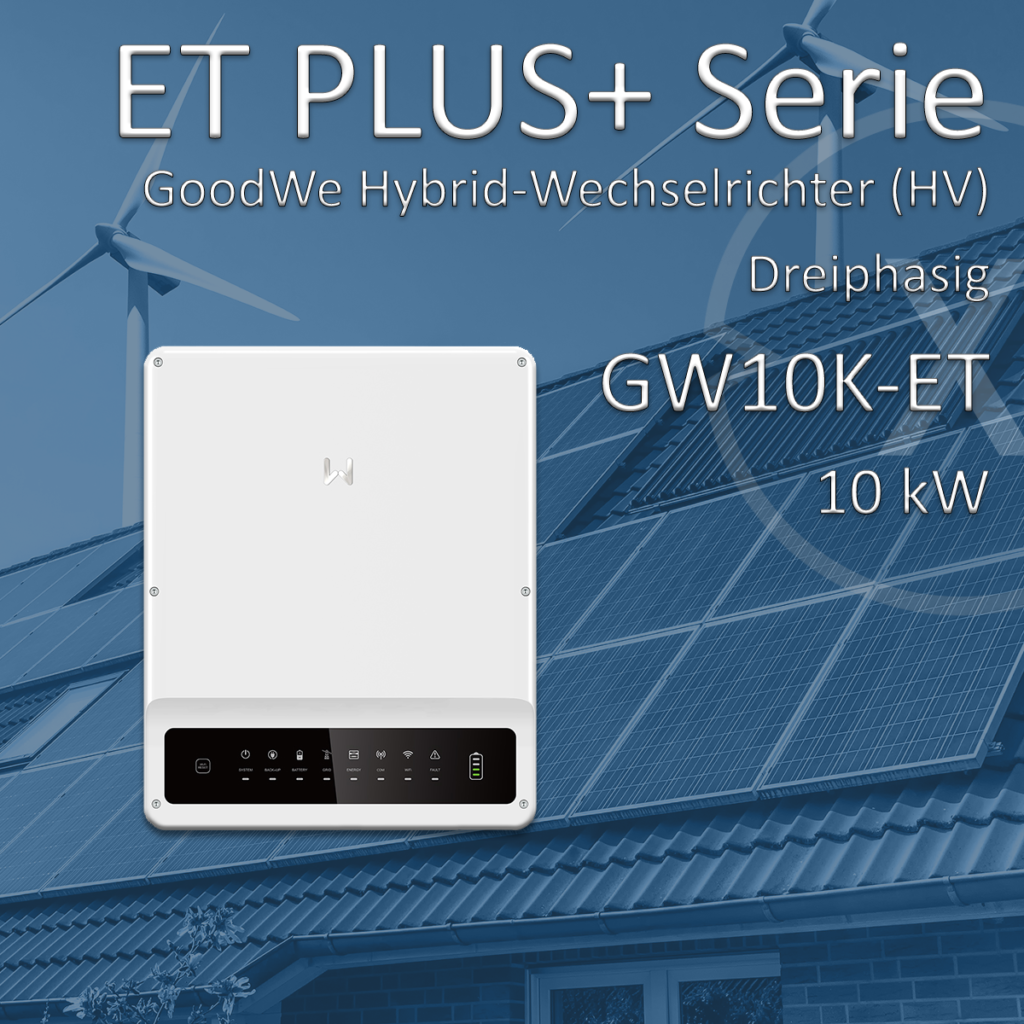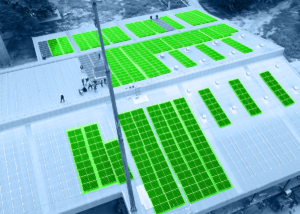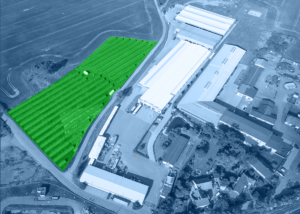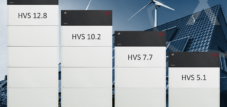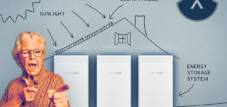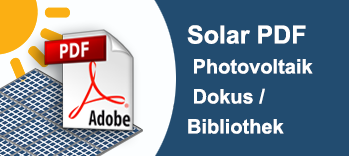Hybrid inverter for home and power storage – hybrid inverter from GoodWe with data sheet (PDF)
Language selection 📢
Published on: December 4, 2022 / update from: August 21, 2024 - Author: Konrad Wolfenstein
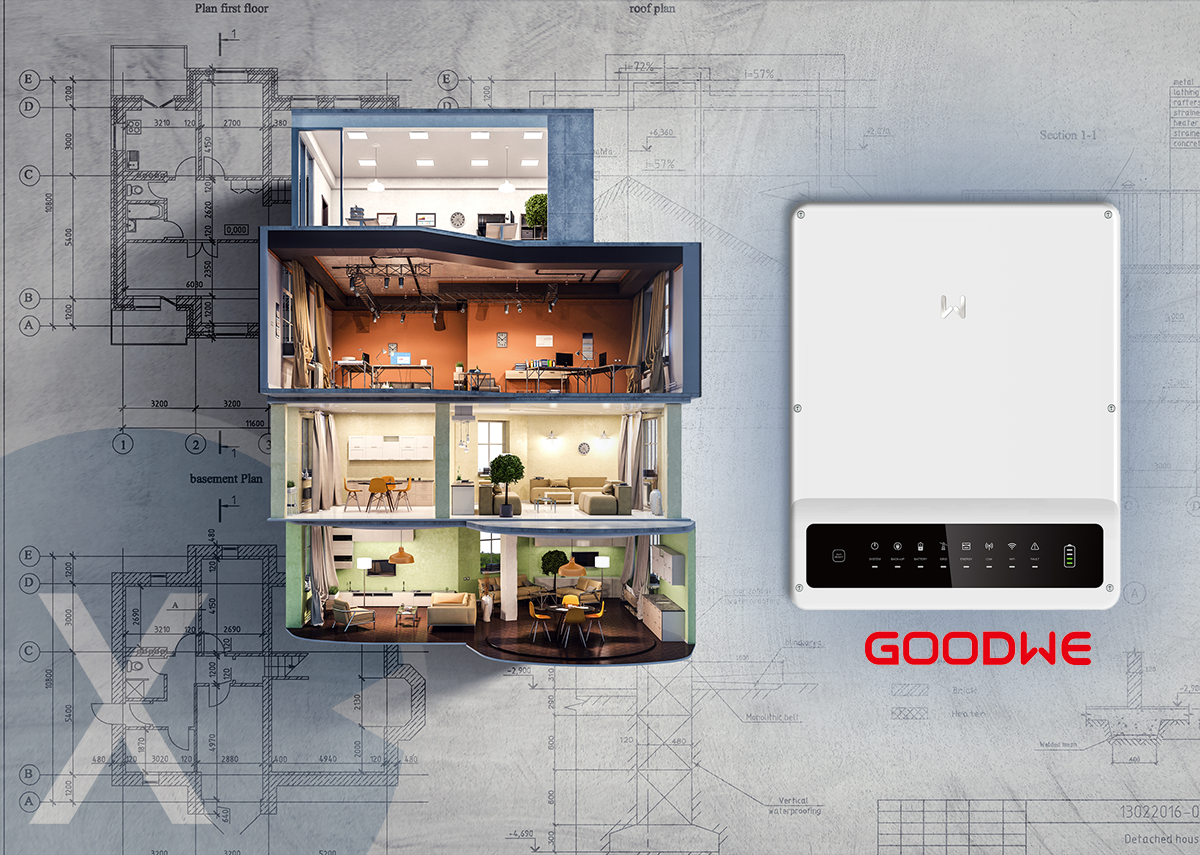
Hybrid inverter for home and power storage – from GoodWe – Image: Xpert.Digital / Sergey Nivens|Shutterstock.com
A hybrid inverter converts the direct current from your solar system into usable alternating current. In addition, it can temporarily store solar power with either an internal or external power storage (also known as energy storage).
The brand new ET-plus series from GoodWe offers three-phase hybrid inverters for high-voltage batteries that enable even more independence in energy supply and maximize self-consumption through intelligent control of loads and higher charging and discharging performance.
The ET-plus series has a power range of 5 kW, 6.5 kW, 8 kW and 10 kW and is 100% capable of uneven loads. It also has a backup function with an uninterrupted switching time. The new ET series is equipped with a potential-free contact, allowing control of the operation of loads such as heat pumps and electric vehicle chargers.
- Intelligent control of loads
- 150% DC oversizing
- 100% uneven load capacity
- Direct connection of a ripple control receiver
- Backup with uninterrupted switching
Temporarily store solar power with a hybrid inverter
A hybrid inverter is a clever combination of a conventional inverter and energy storage. It converts the direct current from your solar system into usable alternating current and can also temporarily store solar power with either an internal or external solar battery. This means you can use the electricity you generate yourself at any time - even when the sun isn't shining.
Installing a hybrid inverter makes particular sense if you already have an existing solar system. With a hybrid inverter, you can easily supplement your existing system and immediately benefit from the advantages of storing electricity.
The inverter in the hybrid system with a power storage unit
Most inverters for hybrid systems with a power storage system are intelligent devices that automatically regulate various parameters. This includes the voltage (volts), the power (watts) and the quality of the electricity that is charged by the energy storage device.
However, some inverters also have manual controls, so you can make the settings yourself. In this case, you should contact the manufacturer to find out which parameters can be influenced and which cannot.
If you want to install a hybrid system with an inverter and a power storage unit, you should make sure that it has been specifically developed to operate in such a system. This is the only way to ensure that it provides all the necessary functions and optimally synchronizes with the power storage system.
Also make sure that the hybrid elements in question, such as inverters and power storage devices, are compatible with each other, as this is not always the case.
It is also important to know what requirements are placed on the inverter. In particular, you have to ask yourself whether the inverter is primarily intended for use with a photovoltaic system or for use with a wind energy system. Depending on the purpose for which the inverter is intended, different models come into question. The requirements for an inverter also depend on the size of the photovoltaic system:
- Micro inverter
- String inverter
- Multistring inverter
- Central inverter
Single phase or three phase inverter?
A three-phase inverter can offer many advantages over a single-phase inverter. For example, it can deliver higher voltage and power and is more robust. Above 4.6 kVA, a three-phase inverter is mandatory. Of course you could connect a 5.76 kW system to a 4.6 kVA inverter, but this would result in major losses.
Although small systems can still be operated with a single-phase inverter, this is not advisable as there are no options for expansion or modernization.
The difference between volt amps and watts
Volt Amps (VA) = Volts x Amps
Watts = Volts x Amps
In fact, at first glance there is no difference.
The difference lies in the detail and the way it is viewed or used. Here are a few good approaches:
- The momentous difference between watts and volt amps
- The difference between volt-amperes (VA) and watts (W) explained simply
- What is the difference between VA and Watt?
For simplification:
I explained it to my children in such a way that watt is called where the electrical energy is used and used, ie “consumed” or converted - into light, heat, etc.
VoltaMere is where the electricity comes from and is ready for use. So “in front of the door” or at the socket for the use “wait”.
When it comes to the inverter, that fits quite well. The links above explain in detail why there are differences.
GoodWe ET series and the ET Plus series – also hybrid or bidirectional solar inverters
The ET Series and ET Plus Series, also called hybrid or bidirectional solar inverters, provide energy management in a PV system that includes solar panels, a battery, loads and a grid connection.
The energy generated by the PV system is primarily used to supply consumers and excess energy is used to charge the battery. When the battery is fully charged, excess energy can be released into the utility grid (if permitted).
The inverter power limit (WGra) does not apply to the operation of the mode of changes in power source operation.
The battery discharges to support loads when PV output is insufficient to meet self-consumption needs. If the battery power is insufficient, the system draws power from the public grid to supply consumers.
PDF download for GoodWe hybrid inverter (HV) ET PLUS+ series - 5-10 kW | Three-phase
- GoodWe Hybrid Inverter User Manual ET Series and ET Plus Series
- GoodWe hybrid inverter data sheet (HV/high voltage) ET PLUS series
- GoodWe Hybrid Inverter Installation Quick Guide ET Series
- GoodWe hybrid inverter operating instructions for the ET series
Technical data - GoodWe hybrid inverter GW5K-ET (ET PLUS+ series)
Battery input data
Battery Type : Li-ion
Battery Voltage Range (V) : 180~600
Max Charge/Discharge Current (A) : 25
Li-ion Battery Charging Strategy : Self-adaptation to BMS
PV string input data
Max DC Input Power (W) : 6500
Max. DC input voltage (V)*1 : 1000
MPPT range (V) : 200~850
Starting voltage (V) : 180
Min. input voltage (V)*7 : 210
MPPT full load range (V) : 240~850
Nominal input voltage (V) : 620
Max. input current (A) : 12.5/12.5
Max. short-circuit current (A) : 15.2/15.2
Number of MPP trackers : 2
Number of strands per MPPT : 1/1
AC output data (grid-connected)
Nominal apparent power to the mains (VA) : 5000
Max. apparent power to the mains (VA)*2*6 : 5500
Nominal apparent power from the mains (VA) : 10000
Max. apparent power from the mains (VA) : 10000
Nominal output voltage (V) : 400/380 , 3L/N/PE
Rated output frequency (Hz) : 50/60
Max. AC current output to mains (A) : 8.5
Max. AC current from mains (A) : 15.2
Output power factor : ~1 (adjustable from 0 .8 leading to 0.8 lagging)
Output THDi (at nominal power): < 3%
AC output data (backup)
Back-up rated apparent power (VA) : 5000
Max. output apparent power (VA) : 5000
Peak output apparent power (VA)*3 : 10000, 60 sec.
Max. output current (A) : 8.5
Rated output voltage (V) : 400 /380
Rated output frequency (Hz) : 50/60
Output THDv (at linear load) : < 3%
Efficiency
Max. Efficiency: 98.00%
Max. Battery-Load Efficiency: 97.50%
European Efficiency: 97.20%
MPPT Efficiency: 99.90%
* Current certificates can be found on the GoodWe website.
*1 For a 1000V system, the maximum operating voltage is 950V. For AustraliaL safety, a warning will be issued when the PV voltage is > 600V.
*2 According to local grid regulations.
*3 Can only be achieved when the PV and battery power is sufficient.
*4 CAN communication is configured by default.
If 485 communication is used, please swap the corresponding communication line. *5 No backup output.
*6 Max. output apparent power (VA) for Belgium: GW5K-ET: 5000;
GW6.5K-ET: 6500; GW8K-ET: 8000; GW10K-ET: 10000. *7 If no battery is connected, the inverter only starts feeding when the string voltage is higher than 400 V.
Technical data - GoodWe hybrid inverter GW6.5K-ET (ET PLUS+ series)
Battery input data
Battery Type : Li-ion
Battery Voltage Range (V) : 180~600
Max Charge/Discharge Current (A) : 25
Li-ion Battery Charging Strategy : Self-adaptation to BMS
PV string input data
Max DC Input Power (W) : 8450
Max. DC input voltage (V)*1 : 1000
MPPT range (V) : 200~850
Starting voltage (V) : 180
Min. input voltage (V)*7 : 210
MPPT full load range (V) : 310~850
Nominal input voltage (V) : 620
Max. input current (A) : 12.5/12.5
Max. short-circuit current (A) : 15.2/15.2
Number of MPP trackers : 2
Number of strands per MPPT : 1/1
AC output data (grid-connected)
Nominal apparent power to the mains (VA) : 6500
Max. apparent power to the mains (VA)*2*6 : 7150
Nominal apparent power from the mains (VA) : 13000
Max. apparent power from the mains (VA) : 13000
Nominal output voltage (V) : 400/380 , 3L/N/PE
Rated output frequency (Hz) : 50/60
Max. AC current output to mains (A) : 10.8
Max. AC current from mains (A) : 19.7
Output power factor : ~1 (adjustable from 0 .8 leading to 0.8 lagging)
Output THDi (at nominal power): < 3%
AC output data (backup)
Back-up rated apparent power (VA) : 6500
Max. output apparent power (VA) : 6500
Peak output apparent power (VA)*3 : 13000, 60 sec.
Max. output current (A) : 10.8
Rated output voltage (V) : 400 /380
Rated output frequency (Hz) : 50/60
Output THDv (at linear load) : < 3%
Efficiency
Max. Efficiency: 98.00%
Max. Battery-Load Efficiency: 97.50%
European Efficiency: 97.20%
MPPT Efficiency: 99.90%
* Current certificates can be found on the GoodWe website.
*1 For a 1000V system, the maximum operating voltage is 950V. For AustraliaL safety, a warning will be issued when the PV voltage is > 600V.
*2 According to local grid regulations.
*3 Can only be achieved when the PV and battery power is sufficient.
*4 CAN communication is configured by default.
If 485 communication is used, please swap the corresponding communication line. *5 No backup output.
*6 Max. output apparent power (VA) for Belgium: GW5K-ET: 5000;
GW6.5K-ET: 6500; GW8K-ET: 8000; GW10K-ET: 10000. *7 If no battery is connected, the inverter only starts feeding when the string voltage is higher than 400 V.
Technical data - GoodWe hybrid inverter GW8K-ET (ET PLUS+ series)
Battery input data
Battery Type : Li-ion
Battery Voltage Range (V) : 180~600
Max Charge/Discharge Current (A) : 25
Li-ion Battery Charging Strategy : Self-adaptation to BMS
PV string input data
Max DC Input Power (W) : 9600
Max. DC input voltage (V)*1 : 1000
MPPT range (V) : 200~850
Starting voltage (V) : 180
Min. input voltage (V)*7 : 210
MPPT full load range (V) : 380~850
Nominal input voltage (V) : 620
Max. input current (A) : 12.5/12.5
Max. short-circuit current (A) : 15.2/15.2
Number of MPP trackers : 2
Number of strands per MPPT : 1/1
AC output data (grid-connected)
Nominal apparent power to the mains (VA) : 8000
Max. apparent power to the mains (VA)*2*6 : 8800
Nominal apparent power from the mains (VA) : 15000
Max. apparent power from the mains (VA) : 15000
Nominal output voltage (V) : 400/380 , 3L/N/PE
Rated output frequency (Hz) : 50/60
Max. AC current output to mains (A) : 13.5
Max. AC current from mains (A) : 22.7
Output power factor : ~1 (adjustable from 0 .8 leading to 0.8 lagging)
Output THDi (at nominal power): < 3%
AC output data (backup)
Back-up rated apparent power (VA) : 8000
Max. output apparent power (VA) : 8000
Peak output apparent power (VA)*3 : 16000, 60 sec.
Max. output current (A) : 8.5 13.5
Rated output voltage (V ) : 400/380
Rated output frequency (Hz) : 50/60
Output THDv (at linear load) : < 3%
Efficiency
Max. Efficiency: 98.20%
Max. Battery-Load Efficiency: 97.50%
European Efficiency: 97.50%
MPPT Efficiency: 99.90%
* Current certificates can be found on the GoodWe website.
*1 For a 1000V system, the maximum operating voltage is 950V. For AustraliaL safety, a warning will be issued when the PV voltage is > 600V.
*2 According to local grid regulations.
*3 Can only be achieved when the PV and battery power is sufficient.
*4 CAN communication is configured by default.
If 485 communication is used, please swap the corresponding communication line. *5 No backup output.
*6 Max. output apparent power (VA) for Belgium: GW5K-ET: 5000;
GW6.5K-ET: 6500; GW8K-ET: 8000; GW10K-ET: 10000. *7 If no battery is connected, the inverter only starts feeding when the string voltage is higher than 400 V.
Technical data - GoodWe hybrid inverter GW10K-ET (ET PLUS+ series)
Battery input data
Battery Type : Li-ion
Battery Voltage Range (V) : 180~600
Max Charge/Discharge Current (A) : 25
Li-ion Battery Charging Strategy : Self-adaptation to BMS
PV string input data
Max DC Input Power (W) : 13000
Max. DC input voltage (V)*1 : 1000
MPPT range (V) : 200~850
Starting voltage (V) : 180
Min. input voltage (V)*7 : 210
MPPT full load range (V) : 460~850
Nominal input voltage (V) : 620
Max. input current (A) : 12.5/12.5
Max. short-circuit current (A) : 15.2/15.2
Number of MPP trackers : 2
Number of strands per MPPT : 1/1
AC output data (grid-connected)
Nominal apparent power to the mains (VA) : 10000
Max. apparent power to the mains (VA)*2*6 : 11000
Nominal apparent power from the mains (VA) : 15000
Max. apparent power from the mains (VA) : 15000
Nominal output voltage (V) : 400/380 , 3L/N/PE
Rated output frequency (Hz) : 50/60
Max. AC current output to mains (A) : 16.5
Max. AC current from mains (A) : 22.7
Output power factor : ~1 (adjustable from 0 .8 leading to 0.8 lagging)
Output THDi (at nominal power): < 3%
AC output data (backup)
Back-up rated apparent power (VA) : 10000
Max. output apparent power (VA) : 10000
Peak output apparent power (VA)*3 : 16500, 60 sec.
Max. output current (A) : 16.5
Rated output voltage (V) : 400 /380
Rated output frequency (Hz) : 50/60
Output THDv (at linear load) : < 3%
Efficiency
Max. Efficiency: 98.20%
Max. Battery-Load Efficiency: 97.50%
European Efficiency: 97.50%
MPPT Efficiency: 99.90%
* Current certificates can be found on the GoodWe website.
*1 For a 1000V system, the maximum operating voltage is 950V. For AustraliaL safety, a warning will be issued when the PV voltage is > 600V.
*2 According to local grid regulations.
*3 Can only be achieved when the PV and battery power is sufficient.
*4 CAN communication is configured by default.
If 485 communication is used, please swap the corresponding communication line. *5 No backup output.
*6 Max. output apparent power (VA) for Belgium: GW5K-ET: 5000;
GW6.5K-ET: 6500; GW8K-ET: 8000; GW10K-ET: 10000. *7 If no battery is connected, the inverter only starts feeding when the string voltage is higher than 400 V.
Protection - GoodWe hybrid inverter ET PLUS+ series
Islanding protection : Integrated
PV string input reverse polarity protection : Integrated
Insulation resistance measurement : Integrated
Residual current monitoring unit : Integrated Output
overcurrent protection : Integrated
Output short circuit protection : Integrated
Battery input reverse polarity protection : Integrated
Output overvoltage protection : Integrated
General data - GoodWe hybrid inverter ET PLUS+ series
Operating Temperature Range (°C) : -35~60
Relative Humidity : 0~95%
Operating Altitude (m) : £4000
Cooling : Natural Convection
Noise (dB) : <30
User Interface : LED & APP
Communication with BMS*4 : RS485;
CAN Communication with meter : RS485
Communication with EMS : RS485 (isolated)
Communication with portal : Wi-Fi
Weight (kg) : 24
Dimensions (width × height × depth mm) : 415 × 516 × 180
Mounting : Wall mount
Protection class : IP66
Standby Internal consumption (W)*5 : < 15
Topology : Battery not isolated
Xpert hybrid inverter shop
📣 Solar modules for industry, retail and municipalities
Everything from a single source, specially designed for all solar solutions. You refinance or counterfinance into the future with your own electricity generation.
🎯 For solar engineers, plumbers, electricians and roofers
Advice and planning including a non-binding cost estimate. We bring you together with strong photovoltaic partners.
👨🏻 👩🏻 👴🏻 👵🏻 For private households
We are positioned across regions in German-speaking countries. We have reliable partners who advise you and implement your wishes.
- Warehouses, production halls and industrial halls with their own power source from a photovoltaic roof system - Image: NavinTar|Shutterstock.com
- Industrial plant with its own power source from an outdoor photovoltaic system - Image: Peteri|Shutterstock.com
- Plan solar systems with photovoltaic solutions for freight forwarding and contract logistics
- B2B solar systems and photovoltaic solutions & advice
- Plan photovoltaics for warehouses, commercial halls and industrial halls
- Industrial plant: Plan a photovoltaic open-air system or open-space system
- Plan solar systems with photovoltaic solutions for freight forwarding and contract logistics
- B2B solar systems and photovoltaic solutions & advice
That’s why Xpert.Solar for PV and solar systems solutions – advice and planning!
I would be happy to serve as your personal advisor.
You can contact me by filling out the contact form below. I will get back to you right away
I'm looking forward to our joint project.
Xpert.Digital – Konrad Wolfenstein
Xpert.Digital is a hub for industry with a focus on digitalization, mechanical engineering, logistics/intralogistics and photovoltaics.
With our 360° business development solution, we support well-known companies from new business to after sales.
Market intelligence, smarketing, marketing automation, content development, PR, mail campaigns, personalized social media and lead nurturing are part of our digital tools.
You can find out more at: www.xpert.digital – www.xpert.solar – www.xpert.plus



